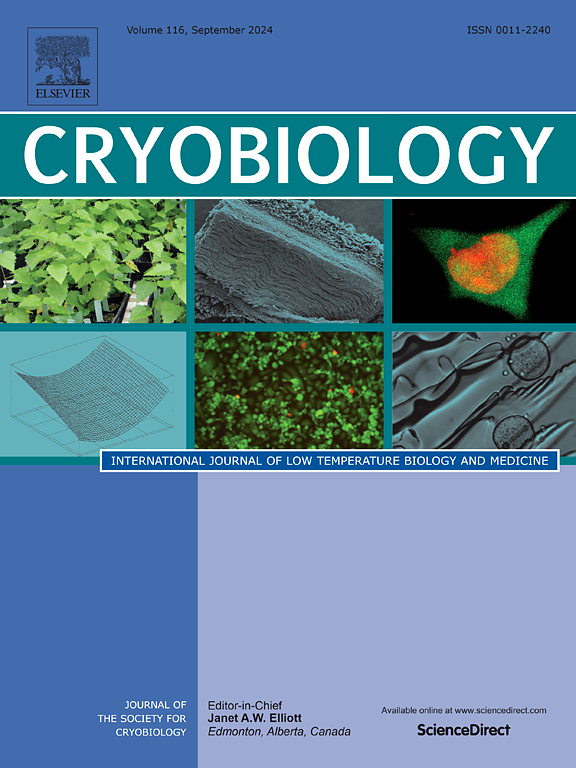Dormant bud cryopreservation of Rubus idaeus L.
IF 2.1
3区 生物学
Q2 BIOLOGY
引用次数: 0
Abstract
Cryopreservation of dormant buds offers a reliable and cost-effective method for the long-term preservation of plant genetic resources, particularly for woody plants like raspberry (Rubus idaeus L.). This study aimed to develop an optimized protocol for the cryopreservation of dormant raspberry buds by investigating the role of dehydration and freezing conditions in maintaining bud viability. Dormant canes of two raspberry varieties, ‘Sanibelle' and ‘Willamette', were collected and prepared by dehydrating single-node cane segments at −4 °C until the desired water content was achieved. The study focused on assessing the impact of dehydration on bud viability and the physical state of water within the buds, using differential scanning calorimetry to analyse thermal transitions during cooling and heating. The cryopreservation process followed a two-step freezing protocol, with the first step involving slow cooling to −30 °C, followed by rapid immersion in liquid nitrogen (−196 °C). After cryopreservation, buds were thawed either slowly at +4 °C or rapidly at +38 °C, with rehydration taking place over 14 days. The study found that the most effective preservation (74–86 % of buds) occurred when the buds were dehydrated to 22–23 % humidity and had a water activity of 0.83–0.85. Rapid thawing significantly improved bud survival, especially for moderately dehydrated buds (with water content 25–35 %), while recrystallization during slow thawing was associated with lower viability. The results highlight the complexity of cryopreservation protocols, where factors such as dehydration levels, cooling and thawing rates, and bud dormancy status play crucial roles in ensuring successful long-term storage.
野樱草休眠芽的低温保存。
休眠芽的低温保存为植物遗传资源的长期保存提供了一种可靠而经济的方法,特别是对树莓(Rubus idaeus L.)等木本植物。本研究旨在通过研究脱水和冷冻条件对保持休眠树莓芽活力的作用,制定一种优化的树莓芽冷冻保存方案。收集两个树莓品种‘Sanibelle’和‘Willamette’的休眠甘蔗,并在- 4°C下将单节甘蔗段脱水,直到达到所需的含水量。该研究的重点是评估脱水对芽活力和芽内水分物理状态的影响,使用差示扫描量热法分析冷却和加热过程中的热转变。冷冻保存过程遵循两步冷冻方案,第一步缓慢冷却至- 30°C,然后快速浸入液氮(- 196°C)。冷冻保存后,芽在+4°C缓慢解冻或在+38°C快速解冻,并在14天内进行再水化。研究发现,当芽脱水至22 - 23%湿度,水分活度为0.83-0.85时,芽保存效果最好(74 - 86%)。快速解冻显著提高了芽的存活率,尤其是中度脱水的芽(含水量为25 - 35%),而缓慢解冻时的再结晶则降低了芽的存活率。研究结果突出了低温保存方案的复杂性,其中脱水水平、冷却和解冻速度以及芽休眠状态等因素在确保成功的长期保存中起着至关重要的作用。
本文章由计算机程序翻译,如有差异,请以英文原文为准。
求助全文
约1分钟内获得全文
求助全文
来源期刊

Cryobiology
生物-生理学
CiteScore
5.40
自引率
7.40%
发文量
71
审稿时长
56 days
期刊介绍:
Cryobiology: International Journal of Low Temperature Biology and Medicine publishes research articles on all aspects of low temperature biology and medicine.
Research Areas include:
• Cryoprotective additives and their pharmacological actions
• Cryosurgery
• Freeze-drying
• Freezing
• Frost hardiness in plants
• Hibernation
• Hypothermia
• Medical applications of reduced temperature
• Perfusion of organs
• All pertinent methodologies
Cryobiology is the official journal of the Society for Cryobiology.
 求助内容:
求助内容: 应助结果提醒方式:
应助结果提醒方式:


